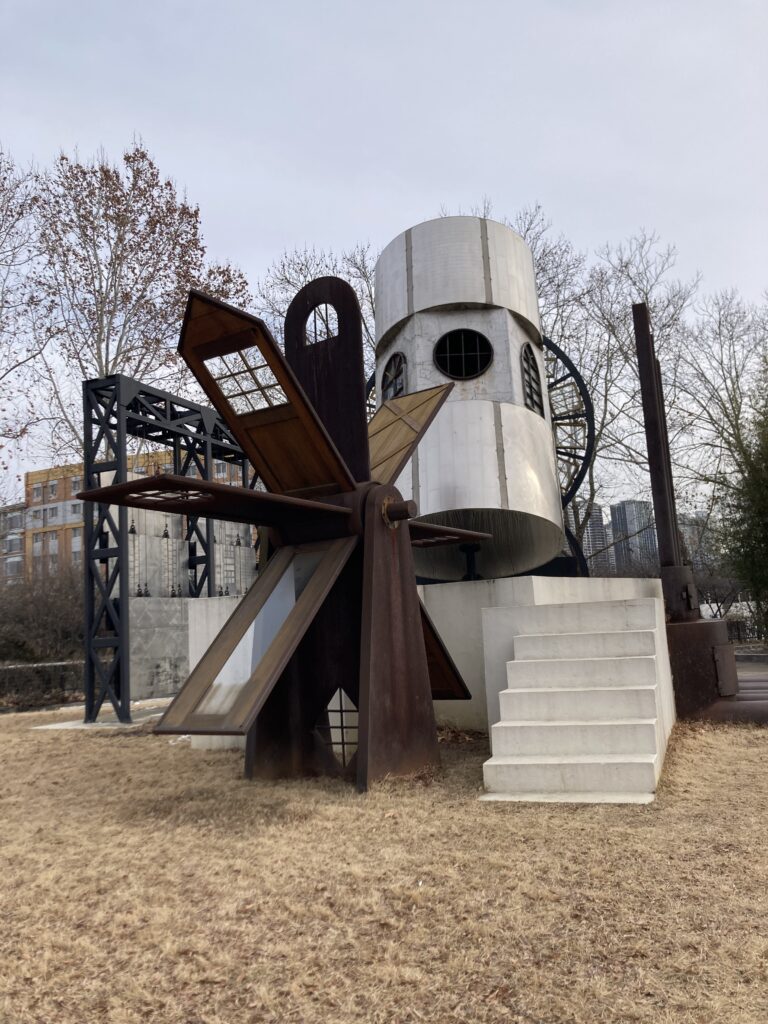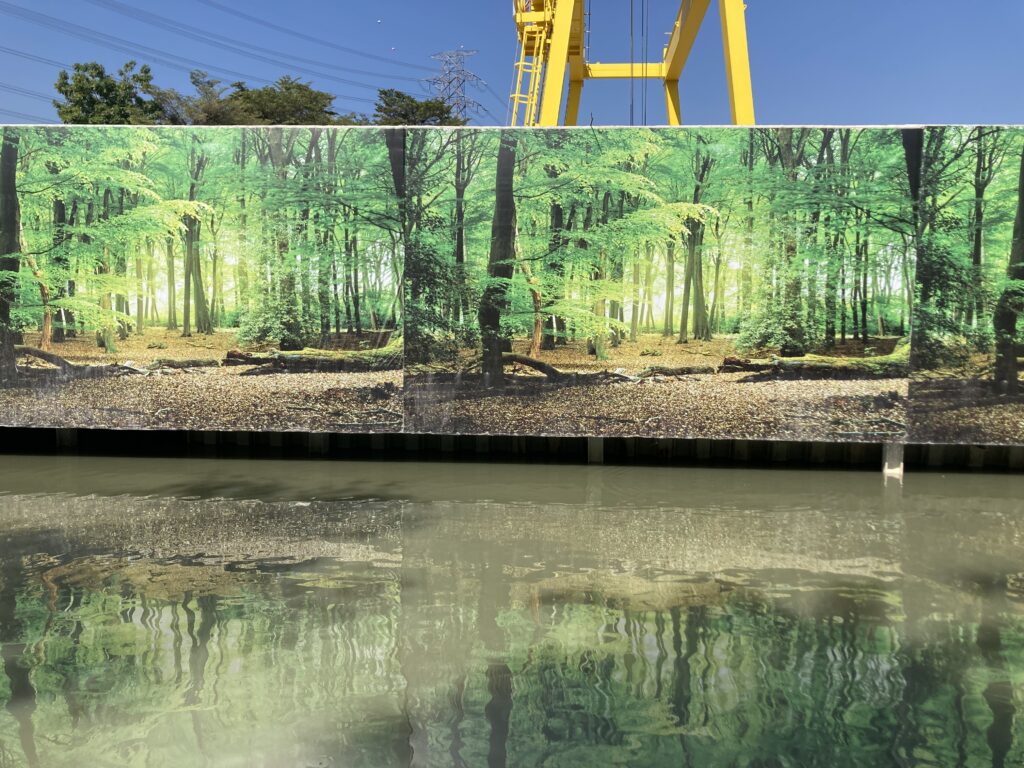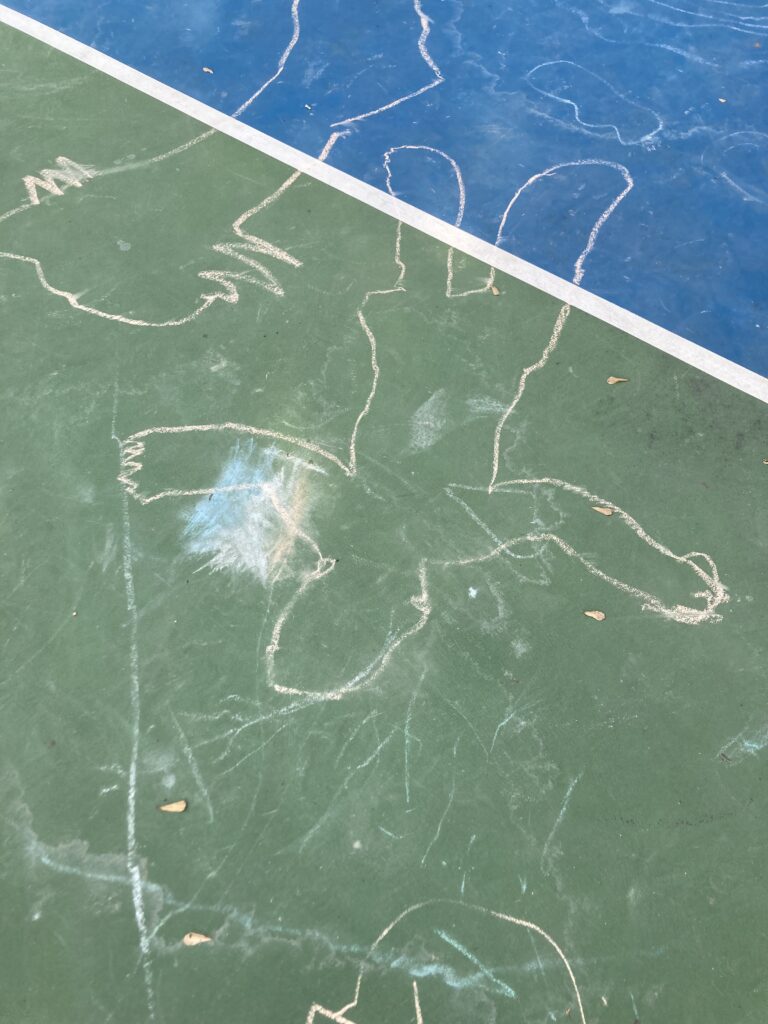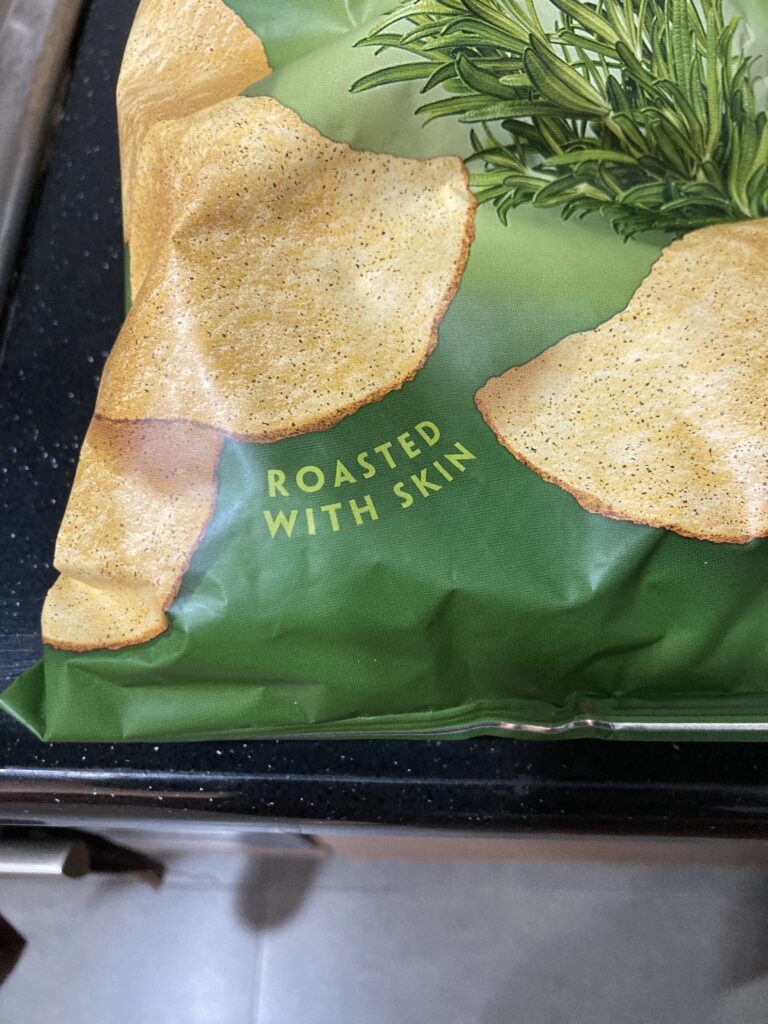revolving door


‘Previously (and still technically) called ‘Lake Wells,’ ‘Lake Slime’ was, some years ago, infected with a European strain of algae that has absolutely thrived in its new home. This algae has transformed the water into a sort of gel- a slime- that has proven resistant to the (admittedly limited) attempts to eradicate it. The high water-content of the slime makes it resistant to heat and fire. Chemicals tend to slide off the surface of the slime, poisoning the wildlife around it. Actually solving the problem would prove to be complicated and expensive.
And, for the most part, the algae’s damage is done. The fish in the lake died and were pushed to the surface for birds to pick at. The surrounding animals proved willing to, for lack of a better word, chew their water and nature adapted. The only downside proved to be a sharp decline in the recreational value of ‘Lake Wells.’
Then, a video emerged of a local teen running across ‘Lake Slime,’ relying on the slime’s non-Newtonian viscosity. Comments on the video, which soon went viral, pointed out that the depth of the lake reached 20’ at its center and that swimming in the slime would prove difficult or impossible if, say, the same teenager were to trip halfway across. This only exasperated the virality of the video. Copycats proved the stunt could be performed again and then one would-be copycat, a thirty-year old family influencer from several states away, drowned in the exact manner laid out in those early comments.
‘Lake Slime’ is closed to the public but, like the attempted eradication of the slime, those barriers and signs installed to actually keep the public out seem inadequate compared to the situation beyond and the viral pull of possible celebrity.’
Despite the relative fame of ‘Lake Slime,’ its distance from anything else of interest seems to do a better job of keeping visitors away than the waist-high fence and finger-wagging signage that suggests danger past a certain point. Credit should be given to the artist of said signs, however. Given the task of illustrating the theoretical demise of an influencer in a lake of slime with blocky shapes in yellow and black, they have risen to the challenge. A stick man, with a backward baseball cap, screams for help as someone films with their phone from shore. The man’s up to his chest, past the point of saving, I’d guess, even if the audience (here represented by just a phone-in-hand) took up a rope and attempted a rescue.
Which they haven’t.
It’s stupid, to think that crossing the lake is a good idea, but here’s the thing, reader. My sense of what it means to have experienced a destination is vaguely defined, sometimes leaning into the danger of a place and sometimes leaning away. I don’t know until I feel it and, when I arrive at ‘Lake Slime,’ I know, almost right away, that I will have to attempt it myself to feel justified.
It’s not an ideal way to be.
On my side is ample evidence of this being possible. Sure, one man tripped and fell, but there are countless other videos of people heavier than me taking the lake at something like a fast walk- of becoming so confident that they do a few circles in the middle, holding their hands out to either side and grinning at their videographer as if to say, See? This is easy.
They make it look fun, and while I don’t intend to have fun, it seems ridiculous to me that someone could have fun doing something I wouldn’t even attempt due to fear. Not here. Not on the Wayside, where I’ve made my home.
So, I check the laces on my boots- tied, but not so tight that I won’t be able to abandon them to the slime for a second chance at escape if I start to sink. I set my backpack on the shore and stretch, maybe for the first time in my life. I throw a rock out into the middle and watch it sink slowly below the surface, hoping it will make me feel better about what I plan to do (or so poorly that I change my mind). It has neither effect, so I remain in the position of knowing I’m about to do something stupid.
I step back and take the slime at a running start. It bounces underneath my steps, propelling me forward such that I worry I’ll topple, but then I embrace the speed it gives me and my pace stabilizes and suddenly I’m walking on water.
The Wayside can be playful, the way a cat is playful. Willing to show its belly. Happy to bite when it’s finished being stroked. I play, for a while, and I stop when I know it’s time. We’re familiar, now, the Wayside and I. Not friendly, maybe. But familiar.
-traveler

It is nail-biting, inching toward ‘The Intersection with No Sign.’ It is the drawn-out stress I haven’t felt since speeches in high school, sitting in my desk while Mr. Mickel hemmed and hawed over who ought to go next, knowing I should volunteer and get it over with but failing to raise my hand all the same. All approaches to ‘The Intersection’ are blind up till about half-block before, the left and right concealed by the towering office buildings of downtown Dallas.
The radio cuts in and out. There is supposed to be a pirate station, one that dedicates itself solely to traffic at ‘The Intersection with No Sign,’ attempting to coach vehicles into order from an unknown birds-eye perch. That station is quiet today, which is not uncommon but certainly inconvenient. Traffic is bad. Cars move slowly ahead. The height of the RV allows me to see a brief glimpse of the chaos ahead. A compact car has been signally right for nearly three minutes. It decides, last minute, to go straight. An oncoming truck bullies its way forward. The two graze. Horns begin to honk as the two drivers exit their vehicles to assess the damage.
At least they don’t live in their cars.
‘Every attempt to add signage to ‘The Intersection with No Sign’ has failed spectacularly, it being a running and highly conservative joke about the price of personal freedoms and small government and such. This extends, even, to measures that would ease traffic around ‘The Intersection,’ modifying certain one-way streets so that it would not be so vital to rush hour traffic in one of the city’s busiest strips of road.
No, ‘The Intersection with No Sign’ is the pet disaster of the locals and it is something of a spectacle when the planets align and approaching cars zip smoothly past each other, caught in a shared dance that is equal parts skill and happenstance.
Of course, ‘The Intersection with No Sign’ averages seven fatalities each year. Hardly the most dangerous destination on the Wayside, we leave it to the reader to decide whether this particular juice is worth the squeeze.’
-an excerpt, Autumn by the Wayside

‘Forgotten, at times, among the myriad extinctions of our age, is a near-global mourning of the loss of the ‘third space.’ For the uninitiated, a third space is a location outside of one’s home and workplace, normally meant for socializing- a place for meeting friends. Malls traditionally filled the role of third space in America and we’re finding that they were something of a keystone in the intricate social patterns of humans, particularly young humans who are not yet welcome in bars and are still too cool for their local library. The malls haven’t disappeared entirely, of course, but those that survive are largely unwell, riddled with empty stores and tumorous stall-based merchants. They, like a terminal grandparent, do not appeal to children. They repulse them.
Young people, these days, would rather stay home than visit a mall. They would rather stream videos to their phones, cradled between their legs in a comfortable chair while a flatscreen television screams boomer media into the void on the horizon. Kids these days would rather vape in their cars and argue about the best flavors of marijuana edibles.
Kids these days would rather skip third places entirely, and they have begun visiting the forbidden ‘Fourth Place,’ and this is a concern for us all.
‘The Fourth Place’ is considered an American destination because it can only be accessed in-country. For all other intents and purposes, ‘The Fourth Place’ is a location outside of space, a flat white plane with little variation in terrain or atmosphere. Bodies do not seem to exist in ‘The Fourth Place.’ It is a realm for consciousness alone and it is both vast and crowded. Thoughts arrive uninhibited in ‘The Fourth Space.’ They are shared via entanglement, an act that youths tend to perform with no particular consideration of the dangers involved. Studies have shown that participants in entanglement sometimes exit with foreign thoughts- with ideas that could not have been their own. Sometimes these thoughts are good. Other times they are cruel.
This is the appeal of entanglement: the integration of strange thoughts.
‘The Fourth Space’ has several branches in most states, a full list can be found in the appendix. Responsible travelers should complete a mental audit before visiting, via their preferred meditation technique, as youthful consciousnesses have been known to swarm unsuspecting newcomers with uncomfortable mental narratives and earworm jingles that no earthly song can exorcise.’
Entrances to ‘The Fourth Space’ occur naturally. That’s what the current science says, anyway. Most have now been monetized, of course, they having been discovered on private lots in an age before regulatory laws could catch up to such things. I find a cheap entrance so far up north that I may as well be in Canada. It’s cold, for autumn, and the entrance is in a tin shed. A sign inside asks visitors to leave ten dollars in a jar. Honor system. When I arrive the jar holds one dead fly. I empty it on the floor and put my money in. I enter ‘The Fourth Space’ via a hole in the wall. My body is not left behind, but it isn’t with me either. Everything goes white.
Then the voices.
In the end, ‘The Fourth Space’ isn’t quite as bad as it’s made out to be. It’s annoying, really, and annoying in a way that signals to me that I’m getting old. The Wayside is beginning to adjust itself, shifting to incorporate the uncomfortable run-off of new generations and, in doing so, shedding the skin I’ve grown familiar with. I’m not sure how much longer I’ll have a place, here.
And I’m not sure where else there is to go.
-traveler

The ripe smell of decay works its way through the air conditioners just as I begin to see signs for ‘The Rot Garden.’ I assume enough time has passed since incident at ‘The Root Garden’ that anybody who noted me as a visitor would have forgotten my face and I wouldn’t become entwined in what, as far as I can tell, it a name-based turf war between two totally different locations. The signs are not what I expect from the grunge punk food attack that occurred at ‘The Root Garden.’ In fact, the advertising tone is nearly identical to that of ‘The Root Garden-’ emphasizing natural processes and a side of nature few get to see. ‘The Rot Garden’ does capitalize on gross-out humor in its illustrations, however, showcasing rotting fruit covered in flies, old skeletons dancing in muck, and an earthworm mascot that pleads for visitors to his home.
Only very late and in very small print do any signs mention you might consider eating some of this.
‘It’s just like cheese, they tell you. It’s like yogurt! Or, ah, pickles!
‘The Rot Garden’ and every funny-food destination like it will go to great lengths to make their menu seem appetizing by way of comparison, but the fact that they’re needing to compare at all tends to set them apart. ‘The Rot Garden’s’ more modern, and somehow more persuasive, take is to associate itself with those fringe health movements that, in neglecting large swaths of the food pyramid, resort to fermentation for the natural bacteria the body needs. This includes the all-fruit and all-meat ilk, both of whom will be happy enough with the offerings of ‘The Rot Garden,’ which certainly has bacteria on hand.’
‘The Rot Garden’ is largely open air: a field, a dump, really, with the odd open-air shelter where one might sit and eat. A very small adobe structure rises from the ground in the distance: a cellar, of sort, for encouraging different kinds of rot. A tin shack stands at the entrance, for selling tickets. The perimeter is marked by sun-bleached dumpsters and a cloud of insects fogs the air above.
It all smells terrible.
The man in the shack may very well be one of the people who participated in the attack at ‘The Root Garden.’ He’s wearing a leather jacket and a band tee that’s faded and cracked to such an extent that I can’t read it. He reeks of body odor when he shifts, which is somehow a reprieve from the smell of the place at large. A living stench.
“One please.” I tell him as he looks behind me.
“Cool camper,” he says, “You going to be eating?”
“Uh… is it recommended?”
The man suppresses a smile: “Of course.”
My stomach sinks. “Then maybe something small.”
“That actually makes the ticket cheaper.” He presses a stamp down on the ticket and hands it to me. “We like to encourage people to push their boundaries.”
The tour itself is largely unnecessary. Unlike ‘The Root Garden,’ which reiterated much of what I already knew, the couple that walks me around ‘The Rot Garden’ points out especially nasty molds and insects and describes some of the intersocial drama between employees, including a boss they don’t name but who will disappear for weeks at a time and then reappear with, say, a truck full of soft pumpkins. They don’t seem particularly reverent of the place as an institution or a biome. They swat flies and complain that the boss won’t let them use spray.
Finally they bring me to a picnic table where four more employees join us. A tray with three divisions has been plated with small portions of rotting food: an apple, a strip of unidentifiable meat, and a cream that I hope is yogurt.
“Eat up, man.” The guy from the front hands me a fork. “You want a picture? It’s included.”
I hardly hear him. “Sure.”
After several seconds hesitation, I dip the tines of the fork into the cream and cringe to see that its white surface gives way to something swirled red. I bring the fork to my mouth and, as it hits my tongue, the flash of a camera goes off and the six employees recoil.
“Oh my god, he did it!”
“That’s fucking nasty”
One of the men turns to throw up. The others hold their faces or slap me on the back. By the time I’ve had a chance to indicate I’m done, I realize I never had time to taste whatever they just fed me.
On the way out of ‘The Rot Garden,’ the man tacks my picture to the wall of fame. It’s not a bad picture, but it’s the only one there.
-traveler

© 2024 · Dylan Bach // Sun Logo - Jessica Hayworth